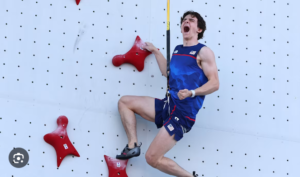Sport climbing, known for its dynamic and challenging nature, has recently soared to new heights by becoming an Olympic sport. But when did sport climbing become an Olympic sport, and what are the pivotal moments that led to its inclusion? This article explores five key milestones in sport climbing’s journey to the Olympics and highlights the sport’s rise to global prominence.
1. The Early Push for Olympic Recognition
Sport climbing’s path to Olympic inclusion began with a concerted effort by the International Federation of Sport Climbing (IFSC) in the early 2000s. Recognizing the sport’s growing popularity and competitive edge, the IFSC sought to elevate climbing from a niche activity to a mainstream sport. This effort involved organizing international competitions, increasing media exposure, and developing a more structured competitive framework. These initiatives were crucial in capturing the attention of the International Olympic Committee (IOC), laying the groundwork for climbing’s future Olympic aspirations.
2. The Tokyo 2020 Olympics: A Historic Debut
The Tokyo 2020 Olympics marked a historic milestone for sport climbing, as it made its debut as an official Olympic event. This was the first time climbing was showcased on the global stage of the Olympics, introducing millions of viewers to the sport. The Tokyo 2020 climbing competition was structured as a combined event, incorporating three distinct disciplines: lead climbing, bouldering, and speed climbing. This combined format was designed to test athletes’ overall climbing abilities and provided a comprehensive view of their skills.
However, the combined format faced criticism from many within the climbing community. Critics argued that merging the three disciplines into one competition did not adequately showcase the specific skills and techniques required for each type of climbing. Despite these concerns, the Tokyo 2020 Olympics was a landmark event that brought significant attention to sport climbing and highlighted its potential as an Olympic sport.
3. The Debate Over the Combined Format of
The introduction of the combined event format at Tokyo 2020 sparked considerable debate among athletes, coaches, and fans. While the format aimed to test climbers’ versatility, many felt it oversimplified the complexities of each discipline. Lead climbing, bouldering, and speed climbing each demand unique skills and strategies, and combining them into a single competition was seen by some as failing to respect the individual nuances of each discipline. This debate was crucial in shaping the future of sport climbing in the Olympics, as it highlighted the need for a format that more accurately represented the sport’s diverse aspects.
4. The Paris 2024 Olympic Format Revision
In response to feedback and criticism from Tokyo, the Paris 2024 Olympics will feature a revised format for sport climbing. For the Paris Games, sport climbing will be split into two distinct events: a combined bouldering and lead climbing competition and a separate speed climbing event. This new structure aims to address the concerns raised about the combined format used in Tokyo and allows for a more detailed evaluation of each climbing specialty. By separating the events, Paris 2024 will provide a clearer picture of athletes’ skills in bouldering and lead climbing, while also showcasing the speed and agility required in speed climbing.
This revised format represents a significant step forward for sport climbing and reflects the ongoing efforts to refine and improve its Olympic representation. The changes are expected to enhance the viewing experience and provide a fairer assessment of climbers’ abilities.
5. The Future of Sport Climbing in the Olympics
Sport climbing’s inclusion in the Olympics signifies a major milestone in its evolution from a niche sport to a global phenomenon. The journey from its early recognition efforts to its current status reflects the sport’s increasing popularity and its ability to adapt to the dynamic nature of the Olympic Games. As sport climbing continues to grow, its future in the Olympics looks promising, with the potential to inspire new generations of climbers and attract a broader audience.
The path of sport climbing from its initial push for Olympic inclusion to its refined format in Paris demonstrates the sport’s resilience and adaptability. As we look forward to the Paris 2024 Games, it is clear that sport climbing will continue to capture the imagination of athletes and fans alike, solidifying its place in Olympic history.
Conclusion
Understanding when sport climbing became an Olympic sport and the key moments in its rise helps appreciate the sport’s rapid ascent and the ongoing developments in its Olympic representation. From its early days to its debut in Tokyo and the upcoming changes for Paris, sport climbing’s Olympic journey is a testament to its growing significance in the world of sports.
ALSO TRY THESE:https://lifesportsandhealth.com/the-art-of-slow-living-balancing-productivity-and-well-being/
Tags: #SportClimbing #Olympics #ClimbingOlympics #Tokyo2020 #Paris2024 #ClimbingHistory #OlympicClimbing #SportClimbingTokyo2020 #ClimbingInParis2024 #OlympicSports


2 thoughts on “When Did Sport Climbing Become an Olympic Sport? 5 Astonishing Moments in Sport Climbing’s Olympic Rise”